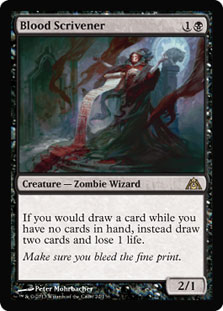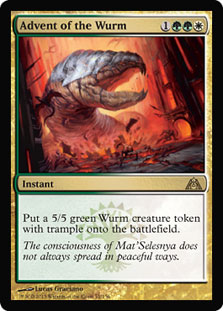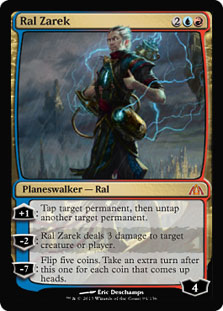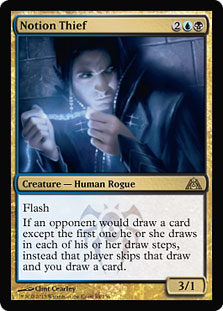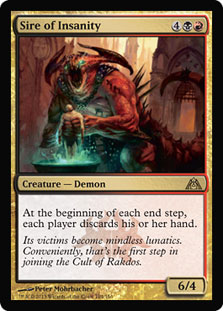Leading into the upcoming Block Pro Tour, I’ve been thinking a lot about the decks I tend to play at events. Or at least the decks I play at events that I think are good. The general theme tends to match [author name="Brian Kibler"]Brian Kibler’s[/author] article on the subject last month: these decks all have a strong proactive game plan.
Of course, last week I said Jund was possibly/probably the best deck in Standard. It has a proactive game plan, but by all measures it’s not a strong one.
A proactive game plan is an easy way to ensure the conditions of a "good deck," but it’s not the only way. My end hypothesis was the following:
"Good decks play good cards" or, more accurately, "good decks try not to play bad cards."
Jund isn’t perfect here, but it’s known as having the best sideboard in the format for a reason. Given the proper attention to detail, the deck will consist of 60 good cards for every post-board game. Even in game 1s it is pretty close. It also does a good job of making its opponents’ cards bad. There’s also a solid core of cards in Jund that are always fine to have in your deck.
So we have three defined relevant cases here: best, worst, and average. There’s also a probability associated with each. We can make up some number and create an EV estimation.
The other big thing to consider is that the difference between best, average, and worst is not constant value. Average cards can make exchanges usually; bad cards often are completely blank.
Using this knowledge, the good cards have one of the following things true about them:
- A very high quality average case and almost no chance worst case.
- A worst case that is rare/non-existent/in a scenario where being down a card is irrelevant and a best case that is common in the context they are played.
An example:
Thragtusk
Best Case
You opponent is attacking with creatures that don’t beat 3/3s in combat and cares about your life total. Thragtusk beats them on every level of this interaction. That or you Restoration Angel it. The first isn’t super common since Thragtusk has basically forced it out of the metagame, but the latter is pretty reasonable to pull off. So the probability of the best case isn’t super high, but it’s reasonable to assume it happens.
Worst Case
Your opponent doesn’t care about a five-drop that only really provides board presence. Basically, they are playing combo. This doesn’t happen often in Standard right now, so the odds Thragtusk is actually a blank is quite low.
Average Case
If your opponent isn’t playing something absurdly unfair (see worst case), odds are Thragtusk is a relevant body for them to deal with. It will either bog things down absurdly well or present a threat that takes two answers to deal with. 5/3 is out of range of being bricked by most things, while the 3/3 side is potentially blank against Restoration Angels and Boros Reckoners. Basically, Thragtusk is going to be a two-for-one almost all of the time.
There we have it. Thragtusk is good. Congrats, we proved the obvious portion of reality. More accurately, we’ve demonstrated a simple example of this analysis.
Where does this come in handy?
New cards.
It’s said again and again that people don’t properly respect the reality of playing with a card when looking at it for the first time. They overemphasize flaws (Boros Reckoner abilities aren’t synergistic!) or assume perfect scenarios (Land Tax unbanning—everyone will draw four cards a turn!). Following a generalized template might seem unnecessary, but it forces you to actually think about things in an appropriate manner when you might otherwise make shortcuts.
Let’s apply this to some of the more hyped and more interesting cards from Dragon’s Maze.
Blood Scrivener
Best Case
You go into a grindy late game where your two-drop is now a very relevant threat and source of card advantage. The problem with this is that very few late games in this format tend to be super grindy. There’s a window for aggro decks to close before they get an Angel of Serenity or Sphinx’s Revelation shoved down their throat. Even a Thragtusk or two bashes you to death quite fast.
Typically, if you start trading cards with the control decks, there is only a turn or two where they are scrambling around and you are applying pressure before something major happens to turn the tables in their favor. The end of this window is usually them casting something you have no ability to recover from. You need to draw specific things with your extra cards for them to matter.
Verdict: Best-case scenario is nice but fairly specific in terms of matchup, timing, and what you have to draw for it to matter.
Worst Case
You are stuck in the midgame unable to empty your hand with a 2/1 when a better body is what you need. That isn’t a really hard scenario to imagine in a world of Thragtusks and Restoration Angels.
But is there a two-drop that doesn’t have this same issue? Realistically, the question here actually boils down to if your deck supports wanting a two-drop. For example, it’s possible you aren’t planning on playing a lot of cards that are significantly better than a 2/1 on turn 2 and wouldn’t realistically replace the slot Blood Scrivener is taking with one.
Interesting other note: what is the reason you can’t empty your hand? Probably because you are short on lands and have high drops that break the midgame stuck there. Again, is it the fault of your two-drop here?
Verdict: Worst-case scenario is awkward but something you can easily design around and is not card specific to Blood Scrivener.
Average Case
How good is a 2/1 right now? Well, this format is really 3/3 heavy, so not great. Still, a deck like Mono-Red Aggro can rely on a bunch of 2/1s. What are the prerequisites for this? Well, you can either put a ton of 2/Xs into play too fast for the blocking with 3/3s plan to matter (Burning-Tree Emissary) or prevent 3/3s from blocking. Blood Scrivener doesn’t really help in either of these cases.
You also have to contend with damage-based sweepers, but that is basically just Bonfire of the Damned. Turns out the black aggro decks have generally been pretty good at beating that card due to Gravecrawler and Geralf’s Messenger.
Overall Verdict: Blood Scrivener has a lot of the flaws that all the other black two-drops have right now. It has little potential to be amazing but isn’t ever completely blank. In the end, it’s still just a 2/1 for two without a huge upside, so odds are Zombies isn’t being revolutionized any time soon—or if it is, it’s not this card’s doing.
Pyrewild Shaman
Best Case
Either +3/+1 for two is creating a very tempo-profitable trade or you are gaining an advantage by repeatedly hitting them and looping this guy.
On the first: what are the toughness jumps we need to make that relevant? Well, the easy one is that +3/+1ing a 3/3 jumps it over opposing 3/3s and Restoration Angel. Pyrewild Shaman pumping a bunch of 2/2s, on the other hand, is not going to be something that wins fights in combat.
On the second: how are we hitting them without killing them while having mana up to do this? Well, the answer to that usually is that some attrition has occurred but they ran out of blockers with you slightly ahead. I talked about this with Blood Scrivener, but that happens for a turn or two at most in this format. Fortunately for Pyrewild Shaman, immediate damage sources are one of the things you would be looking to draw with your extra card. The real question is if you will have five mana hanging around to do that with, to which the answer is "did you draw a blank this turn?"
Verdict: Maximizing the bloodrush on this guy is going to be fairly metagame and deck dependent, but it can be done. As for the rebuys, this card turns blank turns into useful ones, which is about all you want a mana sink to do.
Worst Case
Pyrewild Shaman is still just a 3/1. What if pushing over blockers isn’t what is relevant; instead, the games are ending fairly early while you are both still expending your mana. Also, what if a 3/1 is just a bad body and you are already flooded on three-drops to cast?
Verdict: Don’t play this card against Lingering Souls, and especially don’t play him against The Aristocrats. Also, he is a three-drop, so consider the competition here.
Average Case
How good is a 3/1 for three? Well, it’s not stellar, but three power is definitely a critical point of the format. I’m not especially embarrassed to play this card as is.
I want to point out one awkward overlap here: the good point of this card is pushing 3/3s over Restoration Angels. The point of playing an all 3/3 deck in the context of red aggro is partly to mitigate Lingering Souls. This card is bad against Lingering Souls in a few ways. Opening yourself up to a weakness your deck is trying to avoid is not very optimal.
Overall Verdict: This card is not default amazing and will not fire up new archetypes on its own, but in Experiment One + Mogg Flunkies style decks, a couple copies is pretty reasonable.
Advent of the Wurm
Best Case
You ambush your opponent with a 5/5 in combat. It’s really not that hard to do (see: Restoration Angel) except this isn’t the only ambushing white four-drop in the format (see: Restoration Angel). The additional toughness does let you hop in front of Loxodon Smiters, which is a plus.
You can also populate a bunch of Wurms. I would normally be skeptical here, but Zvi Mowshowitz Bant Delver deck showed there was almost enough incentive to play Rootborn Defenses before this card.
Verdict: Both best cases are pretty reasonable.
Worst Case
Either your opponent has something to punish you for your four-drop being a token or a 5/5 just doesn’t matter. Fortunately, there isn’t a ton of Unsummons floating around. Unfortunately, there is a pretty common creature that punishes vanilla 5/5s pretty well. Beyond this, the worst interaction this card has is "dies to two-drop removal," but the pseudo-haste of being an instant positions it fairly well against that.
Verdict: You need to be sure to have a reasonable response if your opponent plays Thragtusk. Beware
Average Case
There really aren’t a lot of deep things to say here. Four mana for a 5/5 is a pretty solid rate, and flash is a pretty solid ability.
Overall Verdict: As is the case with most cards that just look obviously good on paper, unless there is a reason their exact stats aren’t good in the format, they are probably good. Not much of a worst case, decent high-end reward, and a solid average case return. Odds are Advent of the Wurm will see a solid amount of Constructed play assuming there are 56 other cards worth playing with it.
Ral Zarek
Best Case
The best case with Ral Zarek is the best case with most planeswalkers: stabilize the board and start using it to gain an incremental advantage. Doing this is a bit trickier with Ral as the only permanent advantage it generates before ultimate range is via the -2 ability. It appears comparable to the best case for Liliana of the Veil: -2ing their only relevant creature and then untapping to load up again. The difference is that Ral is already loaded for the second shot.
That said, how many decks are loading up on Boltable guys that won’t plan on having a ton in play when you are on time to cast Ral Zarek? Ral is probably just Bolting once and then dying unless you do some serious work on the front end to clear the way.
Verdict: You have to work for the best case here. It’s not a ton of work, but Ral is just sealing the deal from already being ahead in the cases where it can achieve maximum potential.
Worst Case
You are playing a matchup where your opponent doesn’t have creatures to Bolt down and where the mana jump isn’t especially relevant because tapping out is risky even with them being down a land. While you can’t control for the first part, it should be easy to have small things to do with a couple extra mana. Even then, Ral is still an effective game win in three turns when you -7 it if untap phases are that important.
The real worst case is your opponent is playing a deck where the Bolt is bad but you need to interact with their board AND they either have five power in play to take down Ral immediately or your follow up play doesn’t care about the extra mana. Assuming you build for a tap out style threat, it shouldn’t be too difficult to ensure the latter.
Verdict: Not a lot of absolutely terrible scenarios exist for Ral Zarek, but again you do have to work to make sure he doesn’t do effectively nothing against a segment of decks.
Average Case
Against creatures, the average case seems semi-similar to Liliana of the Veil. Either you kill a guy and gain some life or he activates twice and dies. Unlike Liliana, the second activation is also a kill spell, so that’s a pretty big plus if you have some bodies in the way to let you pull that off.
As for the +1 ability, paying four for a mana rock that also kills something seems somewhat reasonable. My concern is that a lot of the controlling decks right now are pretty good at keeping him off ultimate and not providing targets for the Lighting Bolt ability, making him effectively a Kabira Crossroads / Gemstone Mine combo. I unfortunately think four is a little bit high for that effect.
Overall Verdict: He’s nothing absurd, but part of that is the fact Standard is already preadjusted for the 3/3 stat line. Could easily go bad if a bunch of Reckoners and Loxodon Smiters start flooding the format. I’m not super impressed by the card, but he’s not an auto-dismiss and could easily get much better in the near future.
Notion Thief
Best Case
They play a Sphinx’s Revelation. You play this in the ensuing counter war. I believe the kids use the phrase #GAME these days.
You play this with Whispering Madness, and they have a bunch of cards in hand. Of course, this involves playing Whispering Madness, which either does quite a bit of nothing or is doing way too much for you to want to play a four-drop (see: Windfall). This also involves them having cards in hand and then you afterwards having things to do with your cards, which hopefully aren’t all Whispering Madness. Or hopefully are if that’s your bag. Also, your 3/1 can’t just die on the spot to a removal spell. I feel like this is asking a lot when the last flash dude into four mana sorcery speed blank combo actually straight up killed them instead of letting them untap at least once and attack again.
Verdict: Good versus Revelations, but Whispering Madness is a little too cute.
Worst Case
Your opponent is not planning on drawing extra cards and just wants to dead you. Flash 3/1 is quite embarrassing for four mana against someone just bashing you.
Verdict: I know all of my opponents since Gatecrash was released would be quite sad to see a Notion Thief in their hand if that means something.
Average Case
What about against midrange? Well, as of right now there is not a lot of the card advantage that is not card draw based. Garruk, Primal Hunter really is the only thing that might turn on Notion Thief, while it’s just a 3/1 against Angel of Serenity and Thragtusk.
Also, are we just holding Notion Thief for when they cast Revelation? Playing it in advance opens it up to a ton of removal. In game 1 situations, you may even be punished for having this as your (four mana) answer to Revelation due to their otherwise dead removal. You pay four mana and a supposedly real card; they pay two mana and get to use a bad card.
Overall Verdict: Sideboard material at best. Perfect example of the reality being less cool than it seems.
Sire of Insanity
Best Case
Your opponent has a bunch of cards in hand and plans on continuing this trend for a while (see: Sphinx’s Revelation). They no longer have those cards, and you have a 6/4 that is killing them.
Verdict: Matchup/scenario dependent, but very common against Hallowed Fountain decks to say the least.
Worst Case
You have a bunch of cards to cast that are better and can’t play Sire. This hardly seems like a problem since it implies you have a bunch of good cards and it’s unlikely you can’t cast one of them if you can play a six-drop.
The real worst case is that Craw Wurm is not what you are looking for. This is a fairly reasonable concern considering that rate is well below par for Constructed, but fortunately 6/4 is reasonably sized for exchanges in this format. 6/3 would be a different story.
The control decks you are trying to Mind Twist could just laugh at your Craw Wurm and kill it on sight. Now that I’ve said that, list the instant speed removal in the format. Azorius Charm? Not happening. Ultimate Price? Still nope. You are basically looking at Devour Flesh and Tribute to Hunger, neither of which see much play currently, and the newly returned Putrefy, which while solid isn’t likely to be buddies with Sphinx’s Revelation. Counterspells are a thing, but so is Cavern of Souls.
Verdict: The worst case for Sire of Insanity is that he is a little clunky but still does work. Not a non-existent issue, but certainly not bad.
Average Case
Sire of Insanity does the whole Mind Twist thing fine, but what about the on board issues? While it’s not bad to have him facing down a Thragtusk, it’s not great for either player. If you are behind on board, Sire won’t get you back ahead. It might prevent things from getting worse though. Compare to Rakdos’s Return, which will probably just end the game if cast into a non-lethal Thragtusk in a midrange mirror.
Against creatures, this will have to be your last spell. If your other cards are expected to carry weight at a point after you would want to cast him, don’t expect that to happen. The best example I can think of would be Sphinx’s Revelation, but obviously you aren’t playing this card with that one.
Overall Verdict: This is the card that Notion Thief wants to be. It’s competing with Rakdos’s Return for the same slot, but it’s definitely a debate and might warrant some kind of split. One is better in midrange mirrors, the other against control, and both have benefits against aggro while just being ok there.
I will leave you with one disclaimer: a lot of these reviews are speculative in some manner. Card evaluations vary drastically based on their relative context and nothing is going to change that. As a result, 100% accuracy is near impossible. Of course, with this analysis I’ve laid out a lot of the conditions that trigger said changes. Hopefully, as a result of this process, these evaluations have been through and balanced enough to be as accurate as possible.

